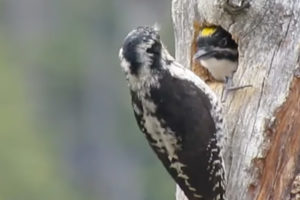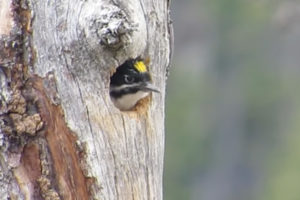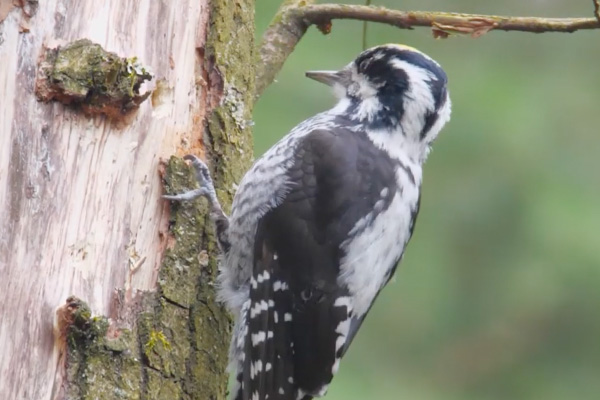American Three-toed Woodpeckers are small woodpeckers in North America that are not attracting much attention. They are often quiet, just perching against a tree without any movements, making it harder for any passersby to notice.
In this article, we will learn more about American Three-toed Woodpeckers. We’ll discuss:
- How to identify them
- Where you’ll find them
- What they eat
- How they nest
- Their behaviors
- How to attract them
- Their conservation status
- Interesting facts
So if you want to learn more about these birds, read on as we go through all bird facts…

American Three-toed Woodpecker Bird Facts
- Common Name: American Three-toed Woodpecker
- Scientific Name: Picoides dorsalis
- Scientific Family: Picidae
- Life Span: 6 years
- Size: 8.3 to 9.1 inches
- Wingspan: 14.6 to 15.3 inches
- Weight: 1.6 to 2.4 oz
- Conservation status: Least Concern (LC)
How To Identify An American Three-toed Woodpecker
American Three-toed Woodpeckers are small-sized woodpeckers that grow at 8.3 to 9.1 inches in length, 1.6 to 2.4 ounces in weight, and have a wingspan of 14.6 to 15.3 inches. They are larger than Downy Woodpeckers but smaller than the Hairy Woodpeckers.
The bird’s overall plumage is black and white but appears messier than most woodpeckers.
- Black back with messy white bars
- Black wings with white dots
- White underparts with fine black bars
- Black face with a white line behind the eye and below their cheeks
- Black-colored tails with white outer tail feathers
Differences Between Male & Female
Male and female American Three-toed Woodpeckers generally show a black and white overall plumage of the same intensity. The only noticeable difference is the yellow crown or patch that you’ll only see on female American Three-toed Woodpeckers.
Differences In Summer Plumage vs Winter Plumage
America Three-toed Woodpeckers look the same all year round.
Where You’ll See American Three-toed Woodpecker
American Three-toed Woodpeckers are widespread birds found in Alaska, Canada, and some areas in the northwestern parts of the United States.
These birds are found in many types of forests. However, their numbers are significantly higher in damaged forests with dead and dying trees as these are where the most food can be found. The bird species can generally stay in any kind of tree, including:
- Black and white spruce
- Jackpine
- Western white pine
- Western hemlock
- Paper birch
- Western red cedar
- Douglas-fir
In other words, they stay in areas where there are many trees, mostly dead or dying, for food or nesting purposes.
American Three-toed Woodpecker Migration Patterns
American three-toed Woodpeckers are nonmigratory birds that generally stay on their range. However, some records indicate that these birds may wander far from their range when looking for more food resources.
Diet and Feeding Preferences
The American Three-toed Woodpecker’s diet is mainly composed of insects. This includes wood-boring beetle larvae, caterpillars, ant larvae, spiders, and moth pupae. They get their food from the bark of dead or almost dying trees, and sometimes they also drink the tree sap, just like most sapsuckers.

American Three-toed Woodpecker Nesting Facts
- Clutch Size: 3-7 eggs
- # of Broods: 1 brood
- Incubation Period: 12-14 days
- Nestling Period: 22-26 days
- Egg Description: White, rather round
A pair of American three-toed Woodpeckers often stay together for more than one breeding season. They then nest in the lower trunk of dead conifer trees, sometimes even in live trees or utility poles.
Nest cavities are excavated by both parents and are lined by wood chips. The male bird is the one who does most of the excavation process at the start, while the female bird is the one who finishes the work.
Cavity size is usually 4 inches across and 11 inches deep and has an entrance of about 1.6 inches in diameter.
American Three-toed Woodpecker Behavior
American Three-toed Woodpeckers spend most of their time foraging alone, only to feed by pair when it’s breeding season.
These birds forage on tree trunks and snags, usually flaking or scaling the barks. They love foraging low, but once they’re in an area with the larger Black-headed Woodpeckers, they move higher up the trees.
Another behavior you’ll notice is they spend a lot of time in a single tree, pecking into it until a bark falls off. Foraging might even be faster when they do it with their partner, as they tend to spend time pecking just one tree.
American three-toed Woodpeckers can be very territorial, regardless if male or female. When another Three-toed Woodpecker enters their breeding territory, both parents get ready to attack:
- They spread their wings and tails
- They sway their heads
- They raise their crest
- They point their bills to their enemies
Tips for Birdwatchers On How To Attract American Three-toed Woodpecker
American Three-toed Woodpeckers rarely visit areas near human settlements. But when they do, it’s most probably only when food is scarce, and you can provide it for them.
Like many birds and woodpeckers, you need to provide them with food, water, and shelter.
These birds mostly eat insects from dead or dying trees, so if those trees stand around your area, don’t cut them if you think it’s still safe. You can also provide them water, especially in winter, which means setting up a heated birdbath would be very helpful to them.
Conservation Status
American Three-toed Woodpeckers are bird species of low concern as their numbers have increased from 1966 to 2015. But there are some threats seen to their growing numbers:
- Their sensitivity to pesticides used to kill bark beetles
- Forest fragmentation
- Predation
As wildfires also help create habitat for these birds, actions like salvage logging, fire suppression, and mechanical thinning can also threaten their numbers.
Fun & Interesting Facts
- As their name implies, American Three-toed Woodpeckers lack the inner hind toe on each foot, leaving them with only three toes.
- Despite being small, they can deliver really powerful blows. Researchers suggest it’s because they only have three toes.
- These birds breed farther north than other North American Woodpecker.
- They are opportunistic feeders that travel where there are outbreaks of beetles.
- They once belonged to one species called “Three-toed Woodpecker” with the European Three-toed Woodpecker.
Explore More Species in This Family
- Williamson’s Sapsucker
- Yellow-bellied Sapsucker
- Red-naped Sapsucker
- Red-breasted Sapsucker
- Lewis’s Woodpecker
- Acron Woodpecker
- Gila Woodpecker
- Golden-fronted Woodpecker
- Red-bellied Woodpecker
- Red-cockaded Woodpecker
- Black-beaded Woodpecker
- Downy Woodpecker
- Nuttall’s Woodpecker
- Red-headed Woodpecker
- Ladder-backed Woodpecker
- Hairy Woodpecker
- White-headed Woodpecker
- Arizona Woodpecker
- Ivory-billed Woodpecker
- Pileated Woodpecker
- Northern Flicker
- Gilded Flicker

from BirdInformer.com https://ift.tt/OCVNFxB

No comments:
Post a Comment